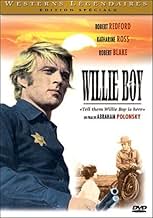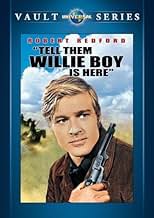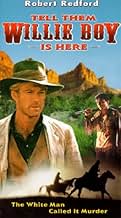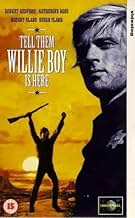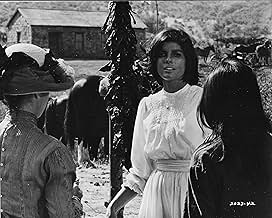En 1909, cuando el joven indio payute Willie Boy regresa a su reserva de California para estar con Lola, una relación que su padre no aprueba, comete un asesinato en defensa propia que pone ... Leer todoEn 1909, cuando el joven indio payute Willie Boy regresa a su reserva de California para estar con Lola, una relación que su padre no aprueba, comete un asesinato en defensa propia que pone en marcha la búsqueda de Willie.En 1909, cuando el joven indio payute Willie Boy regresa a su reserva de California para estar con Lola, una relación que su padre no aprueba, comete un asesinato en defensa propia que pone en marcha la búsqueda de Willie.
- Dirección
- Guionistas
- Elenco
- Ganó 2premios BAFTA
- 3 premios ganados y 1 nominación en total
- Digger
- (as Eric Holland)
- Meathead
- (as Lee De Broux)
- Dirección
- Guionistas
- Todo el elenco y el equipo
- Producción, taquilla y más en IMDbPro
Opiniones destacadas
Willie Boy was a 25 or 26 year old Paiute Indian. Isoleta Boniface was a 15 year old Paiute Indian girl. Isoleta's father, Old Mike Boniface was a Paiute Indian.
Willie Boy had an unrequited interest in Isoleta. Her father didn't like Willie Boy. Willie Boy kidnapped Isoleta the first time from the family's camp at Twenty-nine Palms, Ca. Her father found them, took her back and told Willie Boy that if he came near her again he would kill Willie Boy.
Some days later, after drinking with a White friend, Willie Boy went to the Gillman Ranch, near Banning Ca., where the Boniface family was working and crept up on Old Mike, his wife and their 7 children where they were sleeping under a Cottonwood tree. Willie Boy shot Old Mike in the head as he slept.
Willie Boy kidnapped Isoleta again and headed into the desert. He used her as a pack animal to carry whatever supplies he had. The posse, some of which were Paiute Indians, came upon a message scrawled in the dirt from Isoleta that read, "My heart is almost gone, I will be dead soon". When she couldn't go any further, Willie Boy shot her in the back and killed her.
Lawman Ben Crevecouer said, "The sight of that girl's body was something a person would want to forget, but couldn't. We came on it while it was still warm. Her clothes were just rags, she was welts and bruises all over, and there were cactus spines in her flesh. She had worn through her thin little shoes and her feet were raw and bloody".
The posse eventually discovered Willie Boy's body after chasing him for 11 days and 500 to 600 miles in Riverside and San Bernardino Counties in Ca.. Willie Boy killed himself with his last bullet.
Willie Boy was just a scumbag who murdered two of his own people but ,of course, this director, Abe Polonsky, turns the story into another anti-White Hollywood propaganda film.
Info from interview of Ben de Crevecouer in "Desert Magazine", Nov. 1941.
Every scene is painfully slow in getting to the payoff so that the film seems a lot longer than one hour and thirty-six minutes. The first hour is devoted to the manhunt for an Indian killer (Blake) and then the plot involves the arrival of President Taft in 1909 California and the effort to protect him from any kind of assassination attempt.
Redford's role as the reluctant sheriff is never too clear since he's a man of a very few words (a regular Gary Cooper type), so it's up to Blake to carry much of the film and he does. He's terrific as the Indian lad who's trigger happy when the posse starts getting too close.
The last twenty minutes should have been a model of suspense as they close in on Willie Boy, but it's allowed to drag out interminably.
Summing up: Character driven tale had the potential to be a fine western, but badly paced direction of Abraham Polonsky is no help nor is the sluggish script. Film was released after BUTCH CASSIDY AND THE SUNDANCE KID put Redford on the map but was never a big box-office success.
The title role of Tell Them Willie Boy Is Here is played by Robert Blake who is a Paiute Indian kid who by their tradition kidnaps the women of his intentions Katherine Ross to make her his bride. It's their way of courtship, but when Ross's dad objects he's accidentally shot and killed by Blake.
Ironically with a good lawyer Blake might have gotten off. But Paiute Indians usually don't get good lawyers and they don't take to confinement. Still this incident might have gone unnoticed but for the fact that the sitting president of the USA in 1909 one William Howard Taft was visiting the area. That brings in the national media and blows up the story.
Robert Redford plays the sheriff charged with bringing in Blake dead or alive. He never played quite the roughneck character he does in this film than in any other work I can recall. Susan Clark plays the doctor on the Paiute reservation who has her views routinely ignored as she's mansplained on a regular basis. She also has her needs fulfilled by Redford as both are the best of what's out there in their corner of the world.
It's Blake and Ross who really capture your attention. I'm sure that William Shakespeare would have seen so readily the parallels between his timeless classic and what Blake and Ross are all about.
In 1969, the movie was received as part of the broader counter-cultural movement then flourishing. Certainly several of the film's themes resonated with the social justice wing of the movement, and I'm sure that for leftist writer-director Polonsky the justice-for-the-Indian theme was no stretch.
Seeing the film again after 40-years, I'm struck by how generally low-key it is, despite the highly charged potential. That's particularly the case with the lovers-on-the-run (Blake & Ross). Unlike such fugitive classics as You Only Live Once (1937) or They Live By Night (1947), this version refuses to sentimentalize the lovers. Despite standard expectations, Willie treats Lola pretty harshly and all but drags her along by the hair—a far cry from the usual pathos. Nor, for that matter, is the Coop (Redford)-Elizabeth (Clark) relationship romanticized, as she treats him with general disdain while he sexually humiliates her. (I doubt this film did anything for Redford's lover-boy image.)
At the same time, none of the principals is particularly likable, certainly a departure from usual box-office appeal. Coop may sympathize somewhat with Willie Boy, but he's clearly no reformer let alone racial crusader. He is, after all, an elected sheriff with a race conscious constituency, so his reserve is at least understandable. And, for that matter, neither is Willie Boy very likable. He may be a victim in an extended sense, yet he encourages little sympathy in his headlong flight for survival. If he's meant to represent Indian plight generally, it's certainly not an emotionalized appeal. In fact, the social justice element occurs only sporadically and through biting references to Indians' lesser worth as Indians. So, by no means, is the movie's message "piled on". Note too, how Polonsky refuses to caricature the one vicious racist, Calvert (Sullivan), in the manner of many other anti-racist films.
All in all, the movie comes across as something of an oddity since it follows no particular path other than its own. Clearly, Polonsky wants to avoid the more obvious pitfalls of movies with a message, and largely succeeds, at least in my estimation. However, the caution does come at something of a price. In short, so much of the material is low-keyed that I, for one, was never drawn emotionally into the dramatic events; instead I observed them at a distance, even Willie Boy's last stand, which should have been more of a grabber. Such detachment seems rather paradoxical for a film that should have strong impact given the themes and talent involved. My guess is that Polonsky used perhaps too much caution in dealing with what is admittedly tricky subject matter.
Nonetheless, it remains an interesting film, well acted and beautifully photographed, making good use of the barren edge of California's Mojave desert. I guess my only real gripe is with whoever did Ross's Indian make-up. As another reviewer aptly observes—it looks like it was slathered on with a ladle. Then there's the long lacquered hair that threatens at times to reach around and strangle her. Those minor misfires aside, Polonsky's project remains a curious one-of-a-kind, still worth a look-see, even if it's no longer the rebellious 1960's.
Well paced film with bitter irony and stunningly directed by Abraham Polonsky , this was once-blacklisted Polonsky's first movie in 31 years . A thought-provoking and powerful picture , even though the screenplay carries its liberal conscience on its sleeve . Main cast is very good . Robert Blake is awesome as an obstinate Indian presumed guilty of a crime defined by circumstance rather than by fact, he gradually reverts to being an Indian in the archetypally savage sense . A sober Robert Redford gives fine acting , he plays as a reluctant as well as stubborn sheriff who pursues mercilessly Willie . And Katharine Ross is very attractive as the bride who follows to Boy . Support cast is frankly nice such as Susan Clark , Barry Sullivan , John Vernon , Charles McGraw, Robert Lipton and Ned Romero .
Colorful and evocative cinematography by maestro cameraman Conrad L. Hall including wonderful desert outdoors and masterfully photographed . Special mention for the thrilling and suspenseful musical score with atmospheric and strange sounds by Dave Grusin , in Jerry Goldsmith style . Enjoyable production design with marvelous landscapes by two veteran designers : Alexander Golitzen and Henry Burnstead, Hitchcock's ordinary. The motion picture was compellingly directed by Abraham Polonsky, it was made with austere authority , adding a strong allegory about witch-hunting . This was Polonsky's retun to filmmaking after 21 blacklist years since Force of Evil with this excellent contemporary western . The best and most successful movie he directed was the classic film noir "Force of evil" and also wrote the prestigious Body and Soul . Subsequently , he was chased as a member of the communist party . After defying the comittee by refusing to name names , 8Polonsky was pursued , juzged and condemned by the HUAC , once blacklisted he only wrote and directed a few films as Romance of a horsethief and this Tell them willie Boy is here. And wrote some scripts such as I can get it for you wholesale , Madigan , Monsignor, Avalanche express Rating : 7/10. Better than average , well worth watching
¿Sabías que…?
- TriviaAbraham Polonsky said to a USC film class at the time that he purposely shot and edited the manhunt sequences with characters moving in all directions across the screen, rather than in the usual way wherein both runners and pursuers would move in the same direction across the shots (i.e., left to right) to enhance the impression of urgent suspense in a chase. Instead, Polonsky was looking for a different feel for the audience, of the characters wandering, feeling their way through the landscape. He implied he was willing to sacrifice some suspense to externalize the characters' confusion. He also said that for Katharine Ross' brief, artfully lit nude shot, he exposed the film correctly but then produced a high-contrast copy of the same film frames with deep blacks and transparent lights, then bi-packed both pieces of films together to rephotograph. The high-contrast overlay ensured that the shadows on Ross' body were black--so that the image could not reveal more in the shadows than it was supposed to.
- ErroresMany of the hats worn in the film are not the style worn during the early part of the 20th century. Some in fact, could only have been sewn using machines created in the 1950s, nearly half a century after the film's setting.
- Citas
Dr. Elizabeth Arnold: Willie killed Mike and took Lola. They call it marriage by capture. The mother knew that and told her to go.
- ConexionesFeatured in Red Hollywood (1996)
Selecciones populares
- How long is Tell Them Willie Boy Is Here?Con tecnología de Alexa
Detalles
- Fecha de lanzamiento
- País de origen
- Idioma
- También se conoce como
- Willie Boy
- Locaciones de filmación
- Pioneertown, California, Estados Unidos(shoot out near end, Pipes Canyon)
- Productora
- Ver más créditos de la compañía en IMDbPro
Taquilla
- Total a nivel mundial
- USD 5,949
- Tiempo de ejecución
- 1h 38min(98 min)
- Color
- Relación de aspecto
- 2.39 : 1


